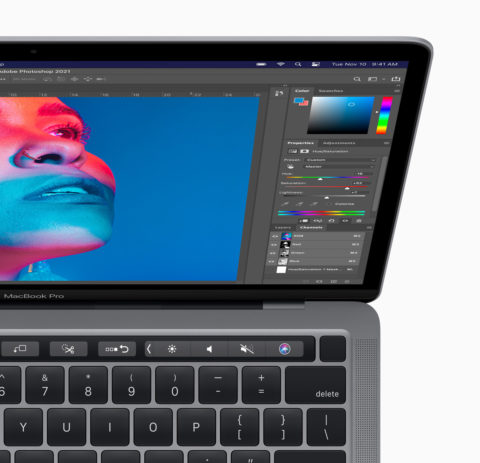Apple just wrapped up its third special event in just 8 weeks. Tim Cook was keen to express just how many new products Apple has launched this Fall despite a difficult year: new operating systems, new iPads, new Apple Watches, new iPhones, Fitness+, Apple One, et cetera. But the Mac computer range has been neglected – until today.
Apple Silicon
Apple promised that the first Mac built with “Apple Silicon” would arrive before the end of the year, and that’s where today’s big announcement comes in. Apple Silicon is “at the heart of” iPhone, iPad, and Apple Watch. The home-grown processing chips are amazingly powerful and energy-efficient, and now these chips are “ushering in a whole new era of the Mac.”
The new system-on-a-chip designed for Mac has been named M1. It’s the first consumer processer to utilize a 5-nanometer chip design – which essentially means more going on in a smaller space than ever. M1 boasts the world’s fastest performance cores, which it claims each offer similar power to the current-generation dual-core MacBooks. And it has four of these cores running. It also boasts an 8-core GPU (graphics processing unit) and a 16-core Neural Engine (for machine learning tasks) with similarly impressive performance scores.
All in all, a lot of technical jargon to say this is a huge leap for the Mac. macOS Big Sur has been optimized for M1, meaning apps now open almost instantaneously and can handle complex tasks like 4K video editing or high-definition 3D gaming with ease. Apple says even web browsing should be faster and smoother than ever.
Not to mention that compared with the previous Intel chips, M1 can deliver 3x more performance per watt. This means way better power efficiency – so longer battery life, less chance of overheating, and lower energy consumption. It can also automatically switch between low- and high-performance cores depending on usage – so if you’re just jotting down a few notes or editing a spreadsheet, you’ll barely impact the battery life.
But which Macs will the M1 chip be available for?
New MacBook Air
It’s no surprise that the first Mac to get the Apple Silicon treatment is its best-selling MacBook Air. Apple says it’s faster than “98% of PC laptops sold in the last year” and 3x faster than the “best-selling Windows laptop in its class.”
There are benefits for battery life, too. Up to 15 hours of web browsing or 18 hours of video playback. 2x longer video calls on a single battery charge.
It’s not just the M1 chip that pimps out the new MacBook Air. It’s also got 2x faster storage, better camera quality, a silent design with no fans, and plenty more small improvements across the board.
Thankfully, despite the huge improvements to the latest model, Apple hasn’t jacked the prices. MacBook Air still starts from $999.
New 13-inch MacBook Pro
There’s another portable Mac to adopt Silicon this year. The best-selling notebook in its class now has an 8-core CPU, offering 2.8 better performance than the previous MacBook Pro. The GPU is 5x faster. Like the MacBook Air, it’s also 3x faster than the “best-selling Windows laptop in its class.”
Thanks to the efficiency of the new chip, alongside Big Sur, it offers the longest battery life ever seen in a Mac. Apple has added studio-quality mics and improvements to the front-facing webcam, too – both of which will be handy in a world with more video conferencing than ever.
Like the Air, MacBook Pro retains the same start price as before, with the basic configuration costing $1,299.
New Mac mini
Apple’s got your back if you prefer a desktop computer, too. After years of neglect to the Mac mini, there’s a bright future for Apple’s tiniest computer. 3x faster processor with 6x faster graphics performance and 15x faster machine learning performance. That means way better results for developers, engineers, and photographers. It’s 5x faster than the top-selling PC desktop. It can even power the Pro Display XDR at 6K resolution.
Mac mini now starts at $699, which is actually less than the previous generation despite a huge performance jump since the previous update.
Availability
Apple promises the rest of the Mac lineup – including the Mac Pro and iMac – will adopt Apple Silicon in 2021. And the three models announced today are available for order immediately, with devices shipping from next week. Are you tempted by an upgrade?
What’s next?
If you’re old and nerdy enough to remember Apple’s previous processor switch, from PowerPC to Intel back in 2006, you may remember a confusing process in which developers had to release separate app versions for each chip – and users had to figure out which one to download. It also took many developers a long time to optimize for Intel at all. Apple says this will be different this time, with big developers on board from day one and “universal apps” meaning no extra downloads. Until apps are updated, the old ones should still work – but won’t take full advantage of Apple Silicon.
There’s also the fact that these M1-powered Macs will soon have the capability to natively run iOS and iPadOS apps, which is a pretty big deal that didn’t get much airtime today. One thing is certain, though – even if your favorite software isn’t available at launch, these new Macs are future-proof and a much better investment than the previous models.

